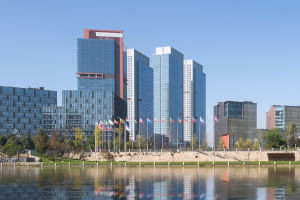In urban environments, climate change intensifies heatwaves, particularly affecting densely populated areas due to the urban heat island effect.
Vulnerability varies between neighborhoods due to overpopulation and limited access to cooling and green space.
Cities are adopting diverse strategies, including green infrastructure, reflective surfaces, passive cooling, shelters, and apps, to protect residents during hot months.
While urbanization has brought climate impacts like the heat island effect, not all urban climate impacts are widely known. The European green renewable energy development program has advanced urban computing and modeling technologies.
Attention to phenomena like domestic haze is more common, but research combining maps to calculate revenue models through rooftop solar panel installations is scarce.
The Swiss Federal Institute of Technology's recent research introduces a program enabling rapid city modeling to analyze how urban buildings influence local weather and climate patterns. This innovation has piqued interest from a shutter manufacturer, and meteorologists are likely to incorporate the model into their analyses.
Urban buildings' shapes, construction, and heat generation significantly impact local weather. Computational modeling enhances local weather predictions' accuracy and provides engineers a basis for optimizing energy consumption in building design.
The CRYOS laboratory's study, simplifying computational schemes, achieved results comparable to traditional models, emphasizing the importance of understanding buildings' impact on weather.
Historically, designers rarely considered buildings' influence on urban weather in architectural plans. However, the project aims to incorporate heat released by urban structures into modern weather forecasting models, proposing an improved scheme.
By creating a model replacing Basel, Mauree calculated density characteristics, establishing "standardized building models" to understand the impact of buildings on weather better.
The decoupled approach, creating complex buildings like Lego blocks, is key to comprehending the influence of urban structures on weather. As building height increases, wind impact rises, leading to heightened energy loss. In hot weather, convection currents intensify, with building surfaces and nearby ground heating significantly.
Architects must consider neighboring buildings' impact on light to design optimal lighting and shading for new constructions.
This comprehensive approach addresses the intricate relationship between urban development, climate change, and weather patterns, paving the way for more resilient and sustainable cities.
In the face of escalating climate change impacts, cities grapple with intensified heatwaves, particularly in densely populated areas vulnerable to the urban heat island effect. Mitigating risks in less affluent neighborhoods that face heightened susceptibility demands innovative solutions.
Urban strategies, from strategic green infrastructure and reflective surfaces to passive cooling and technology-driven safety apps, play pivotal roles. Beyond immediate challenges, pioneering research, like the Swiss Federal Institute of Technology's city modeling program, emerges to comprehend urban structures' influence on local weather and climate.
These advancements promise a more resilient urban landscape, integrating sustainable design principles and cutting-edge technologies for a climate-resilient future.
As cities confront the escalating impacts of climate change, the battle against intensified heatwaves unfolds with strategic urban interventions. The urban heat island effect compounds the challenges, particularly affecting densely populated areas.
An intricate tapestry of vulnerability is woven in less affluent neighborhoods facing heightened risks due to overpopulation and limited access to cooling resources.


